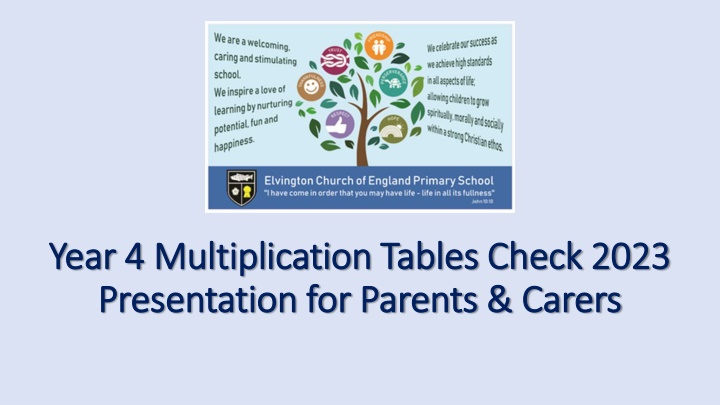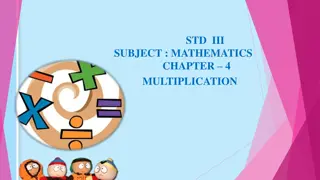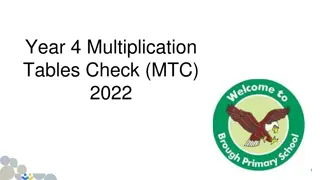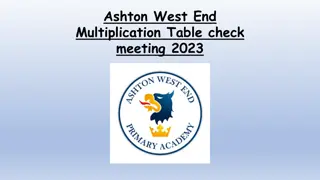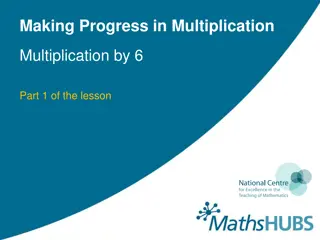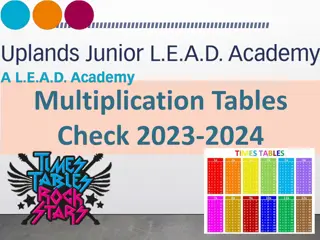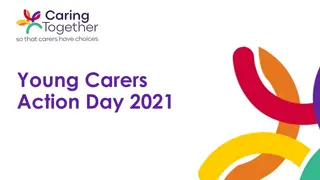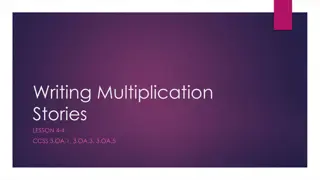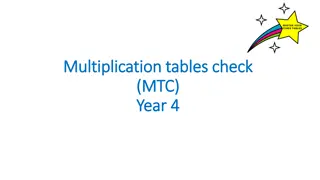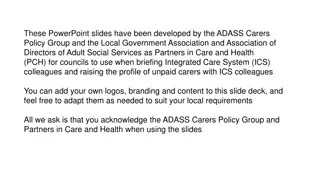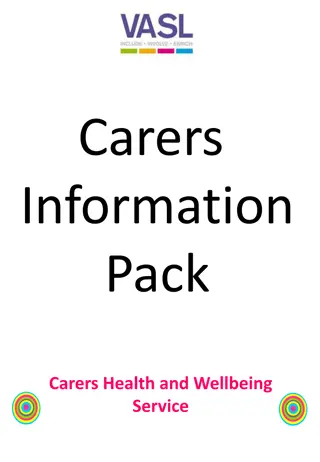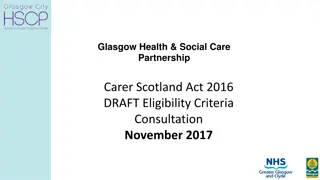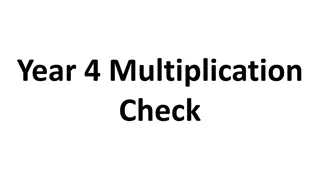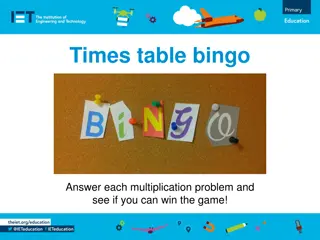Year 4 Multiplication Tables Check 2023 - Information for Parents and Carers
Gain insight into the Year 4 Multiplication Tables Check (MTC) for 2023. Understand its purpose, administration details, specific arrangements, question types, and more. Explore important information regarding how the check is conducted, when it will take place, and what to expect. Children's eligibility for adjustments and the digital nature of the check are also detailed.
Download Presentation

Please find below an Image/Link to download the presentation.
The content on the website is provided AS IS for your information and personal use only. It may not be sold, licensed, or shared on other websites without obtaining consent from the author.If you encounter any issues during the download, it is possible that the publisher has removed the file from their server.
You are allowed to download the files provided on this website for personal or commercial use, subject to the condition that they are used lawfully. All files are the property of their respective owners.
The content on the website is provided AS IS for your information and personal use only. It may not be sold, licensed, or shared on other websites without obtaining consent from the author.
E N D
Presentation Transcript
Year 4 Multiplication Tables Check 2023 Year 4 Multiplication Tables Check 2023 Presentation for Parents & Carers Presentation for Parents & Carers
Important information about multiplication tables check (MTC) The MTC determines if Year 4 children can fluently recall their multiplication tables. They are deigned to help schools identify which children require more support to learn their times tables. There is no pass rate or threshold which means that, unlike the Phonics Screening Check, children will not be expected to re-sit the check. The Department for Education (DfE) will create a report about the overall results across all schools in England, not individual schools. 2
When the check will take place There will be a 3 week window from Monday 5th June for schools to administer the check. There is no set day to administer the check and children are not expected to take the check at the same time. All eligible Year 4 children in England will be required to take the check. 3
How the check is carried out The check will be fully digital. Answers will be entered using a keyboard, by pressing digits using a mouse or using an on- screen number pad. Usually, the check will take less than 5 minutes for each child. The children will have 6 seconds from the time the question appears to input their answer. There will be a total of 25 questions with a 3 second pause in-between questions. There will be 3 practice questions before the check begins. 4
Specific arrangements for the check Some children will be eligible for specific arrangements: Colour contrast; Font size adjustment; Next button (alternative to 3-second pause); Removing on-screen number pad; An adult to input answers; Audio version; Audible time alert. 5
The check questions Each child will be randomly assigned a set of questions There will only be multiplication questions in the check, not division facts. The 6, 7, 8, 9 and 12 times tables are more likely to be asked. Reversal of questions (e.g. 8 x 6 and 6 x 8) will not be asked in the same check. Children will not see their individual results when they complete the check. 6
More information about the questions The Standards and Testing Agency (STA) state that they are classifying the multiplication tables by the first number in the question. For example, 8 x 3 would fall within the 8 times table. 7
Why are times tables so important? Supports mathematical learning, particularly aspects of number (long multiplication, short division) Supports other mathematical learning eg. calculating equivalent fractions, finding the area of a square/rectangle, finding fractions of amounts It will help children to calculate more fluently. (Children can then focus on the method needed to complete a reasoning problem rather than being distracted with struggling to work out the times table) Consequently, children will feel more positive/ confident within maths. Children are expected to know their times tables by the end of Year 4 so that they can work confidently in Years 5/6 and beyond into secondary school. 8
Ways to support times table knowledge Count and look for patterns. Understand that multiplication is repeated addition. Remember that multiplication is commutative. (4 x 8 = 8 x 4 ) Remember that multiplication is the inverse of division. Recall and utilise number families. (6, 7, 42 6 x 7 = 42 7 x 6 = 42 42 / 7 = 6 42 / 6 = 7) Learn tricks such as 5,6,7,8 for remembering 7 x 8 and 8 x 7 = 56 Use different representations to represent multiplication, such as: Concrete manipulatives suck as multilink cubes or counters. Create pictorial representations such as arrays. 9
Counting and looking for patterns. Example: Counting in 2s 2, 4, 6, 8, 10 Ensure children have a strong understanding of counting in groups first. When children are secure with counting, they can then look for patterns. 10
Repeated addition Knowing that 2 x 4 is the same as 2 + 2 + 2 + 2 2 + 2 + 2 + 2 = ? 2 x 4 = ? 11
Multiplication is commutative 3 x 2 is the same as 2 x 3 Children need to understand that multiplication can be completed in any order to produce the same answer. Sometimes this link needs to be made explicit. 3 lots of 2 = 6 2 lots of 3 = 6 12
Multiplication is the inverse of division 20 5 = 4 can be worked out because 5 x 4 = 20 Using pictorial representations (such as arrays) is useful here for children to see the link between multiplication and division. 13
Number families 4 x 5 = 20, 5 x 4 = 20, 20 5 = 4, 20 4 = 5 Due to their commutative understanding, children should also be able to see whole number families. For many children this will need to be pointed out and discussed. 20 4 5 14
Using known facts 12 x 6 = ? I know 11 x 6 = 66 Therefore, 66 + 6 = 72 By using known facts from easier times tables, children should be able to find answers with increasing speed. 15
How best to prepare your child for the check Remind them that the check should last no more than 5 minutes. If you want to go over times tables, make them fun. If you have any concerns, talk to your child s teacher. If your child has any concerns, encourage them to talk to a trusted adult (for example, yourself, their teacher). If you re looking to support your child further with maths at home, there are lots of good websites with free resources e.g. MTC Test URBrainy https://mathsframe.co.uk/en/resources/resource/477/Multiplication-Tables-Check Children can also continue to use Times Table Rockstars to help with this. 16
